
May 18, 2015 | Focolare Worldwide
 At the opening session, Bishop Nunzio Galantino, Secretary General of the Italian Episcopal Conference (IEC), declared that «The spirit of the Episcopal Conference is to start from those involved,» underlining how this is also proven by the meeting which saw the participation of all the ecclesial organisations operating in the social fields. «The ecclesial congress of November will start in Prato, the ideal periphery of Florence and home to Chinese immigrants, and where the Pope is scheduled to make his pastoral visit.» In an interview, Prof. Coda summarised the objective of the two-day work session. «We want to reflect and offer our testimonial through the experiences of some dynamic groups of the Church in Italy, that are working in the frontlines of service to the poor and homeless and in creating an open dialogue in all spheres.» The preparatory meeting delved into the theme on “The Servant of the Lord and the humanity of mankind” (15-16 May), organized by the Abele Group and their magazine, “Il Regno,” with the cooperation of the Italian Catholic Action, Carits, CNCA and the Networks of Charity and the Focolare Movement. “Together with the others, Piero Coda continued, these experiences «open out to all the existential frontiers of society, as Pope Francis says.» Furthermore, «in Evangelii Gaudium, Pope Francis uses a beautiful expression: we must say “yes” to all the new relationships generated by Jesus. All the groups involved in this event actualise in various ways, this “yes to new relationships” with the cultural and social divides, marginalisation of all sorts, the world around us, and the home common to all Creation, precisely as an expression of this reality of relationships.» Maria Voce’s presence underlined the Focolare’s adhesion to this preparatory path which aims above all to highlight the life of those who give all their energy every day to creating this “new humanism.” «The Church breaks through the confines of the building of religious rites, and in full communion between the clergy and laity, comes closer to present day humanity,» she affirmed in her speech. This Convention «targets the start of a new season in the life and mission of the Church in Italy: not only with regard to the pressing need for “pastoral conversion” but also for the role and public conduct of Christians in facing the social, economic and political realities of our country and keeping an open attitude toward Europe and the world.» She then referred to the challenges of pluralism and the need to harmonise the multitude of diversities in the public field. «This new season stands for the transformation of the world, starting from the radical conversion of our hearts and minds in order to be ready to meet Jesus in each person. God cannot receive us alone, he wants us to go to him with our brethren… To give the Christian name of fraternity to social relationships means committing ourselves to harmonizing the weft of relationships, recognising our mutual belonging and the bonds of responsibility implied, and orienting personal and collective efforts towards the common good.» This is why «we must give a voice and dignity to those at the periphery, extend the spheres of inclusion, and heal and rebuild the frayed social fabric. It is primarily the youth who wish to give their own contribution. So many initiatives have started up locally, in the heart of numberless fragments of “fraternal” civil life!» As a confirmation of Maria Voce’s words, were the almost 200 members of the Focolare Movement attending the meeting, and involved in many ways in the ecclesial organisations, and active in various fields: interreligious dialogue, reception of immigrants, politics, culture and legality, schooling, and the real opening of worksites for the good of Italy. It is a participation which demonstrates their concrete commitment, together with many other active groups.
At the opening session, Bishop Nunzio Galantino, Secretary General of the Italian Episcopal Conference (IEC), declared that «The spirit of the Episcopal Conference is to start from those involved,» underlining how this is also proven by the meeting which saw the participation of all the ecclesial organisations operating in the social fields. «The ecclesial congress of November will start in Prato, the ideal periphery of Florence and home to Chinese immigrants, and where the Pope is scheduled to make his pastoral visit.» In an interview, Prof. Coda summarised the objective of the two-day work session. «We want to reflect and offer our testimonial through the experiences of some dynamic groups of the Church in Italy, that are working in the frontlines of service to the poor and homeless and in creating an open dialogue in all spheres.» The preparatory meeting delved into the theme on “The Servant of the Lord and the humanity of mankind” (15-16 May), organized by the Abele Group and their magazine, “Il Regno,” with the cooperation of the Italian Catholic Action, Carits, CNCA and the Networks of Charity and the Focolare Movement. “Together with the others, Piero Coda continued, these experiences «open out to all the existential frontiers of society, as Pope Francis says.» Furthermore, «in Evangelii Gaudium, Pope Francis uses a beautiful expression: we must say “yes” to all the new relationships generated by Jesus. All the groups involved in this event actualise in various ways, this “yes to new relationships” with the cultural and social divides, marginalisation of all sorts, the world around us, and the home common to all Creation, precisely as an expression of this reality of relationships.» Maria Voce’s presence underlined the Focolare’s adhesion to this preparatory path which aims above all to highlight the life of those who give all their energy every day to creating this “new humanism.” «The Church breaks through the confines of the building of religious rites, and in full communion between the clergy and laity, comes closer to present day humanity,» she affirmed in her speech. This Convention «targets the start of a new season in the life and mission of the Church in Italy: not only with regard to the pressing need for “pastoral conversion” but also for the role and public conduct of Christians in facing the social, economic and political realities of our country and keeping an open attitude toward Europe and the world.» She then referred to the challenges of pluralism and the need to harmonise the multitude of diversities in the public field. «This new season stands for the transformation of the world, starting from the radical conversion of our hearts and minds in order to be ready to meet Jesus in each person. God cannot receive us alone, he wants us to go to him with our brethren… To give the Christian name of fraternity to social relationships means committing ourselves to harmonizing the weft of relationships, recognising our mutual belonging and the bonds of responsibility implied, and orienting personal and collective efforts towards the common good.» This is why «we must give a voice and dignity to those at the periphery, extend the spheres of inclusion, and heal and rebuild the frayed social fabric. It is primarily the youth who wish to give their own contribution. So many initiatives have started up locally, in the heart of numberless fragments of “fraternal” civil life!» As a confirmation of Maria Voce’s words, were the almost 200 members of the Focolare Movement attending the meeting, and involved in many ways in the ecclesial organisations, and active in various fields: interreligious dialogue, reception of immigrants, politics, culture and legality, schooling, and the real opening of worksites for the good of Italy. It is a participation which demonstrates their concrete commitment, together with many other active groups.
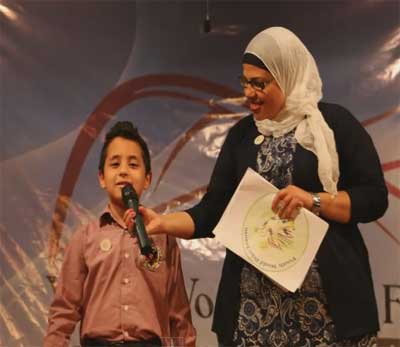
May 15, 2015 | Focolare Worldwide, Senza categoria
 “The Peace Forum was a unique experience. I enjoyed every moment of the programme. Such a meeting (. . .) makes one hope that better days are coming and that one day poverty, hunger discrimination and violence will see their end.” This is how Rasha, an English teacher at Rowad American College, describes Living Peace 2015 which was held in Cairo on May 4-6, 2015, following a three-day congress in Alexandria, Egypt that provided the young people with the necessary background knowledge. In Alexandria there were moments of sharing and mutual understanding, sharing the joys and sorrows that they brought with them from their own countries. In Cairo, there was a beautiful welcome, with festivities along the Nile on a large boat, with games, dancing and song. Then came the actual World Forum of Students for Peace. The project was promoted by New Humanity, an NGO, through the Cayrus project approved by the European Union. Various partners and sponsors from different countries adhered to the project and sent youth representatives to Egypt. For three days 1300 students and professors from more than 20 schools and 8 Egyptian universities shared testimonies of their common commitment to peace: best practices, more than 50 educational projects for peace, workshops, seminars, exhibits and artistic performances. Also present were ambassadors and diplomatic representatives from Argentina, Brazil, Uruguay, Guatemala, Cuba, Democratic Republic of Congo, Cameroon, Pakistan, Portugal, Croatia, Mexico, Germany and Sudan. Begun in 2011 by an English teacher at El Rowad American College of Cairo, as an educational project for peace, today, Living Peace involves more than 2500 students from around the world. A main feature of the project is the way it directly engages the students and teachers in the creation of an educational peace initiative, involving a global network of people and institutions. Membership in the project enables each school to develop projects in accordance with their own possibilities, favouring the creativity of the students along with the awareness that they are contributing towards a common goal. This creates a dynamic of participation that motivates the different components of the school, reinforcing solidarity amongst students, teachers, directors and families, with repercussions in civil society. The 2015 Forum was the occasion for presenting Scholas Occurrentes, the large global network that the Pope wished to see when he was still archbishop of Buenos Aires, and that now connects more than 400,0000 schools around the world. The presence of Dominicus Rohde from Germany, President of the World Peace Forum, raised the tone of the events. Since it was the first world forum held by young people, it opened the doors to a new road. The worldwide forum on peace has awarded the Luxemburg Peace Prize to New Humanity. The prestigious Nelson Mandela Medal was consigned to Cecilia Landucci who represented the NGO in Cairo. See video: Living Peace 2015 https://www.youtube.com/watch?v=nugDbxgoccg&feature=youtu.be Source: ONG New Humanity, AMU e Umanità Nuova. Updated May 27, 2015
“The Peace Forum was a unique experience. I enjoyed every moment of the programme. Such a meeting (. . .) makes one hope that better days are coming and that one day poverty, hunger discrimination and violence will see their end.” This is how Rasha, an English teacher at Rowad American College, describes Living Peace 2015 which was held in Cairo on May 4-6, 2015, following a three-day congress in Alexandria, Egypt that provided the young people with the necessary background knowledge. In Alexandria there were moments of sharing and mutual understanding, sharing the joys and sorrows that they brought with them from their own countries. In Cairo, there was a beautiful welcome, with festivities along the Nile on a large boat, with games, dancing and song. Then came the actual World Forum of Students for Peace. The project was promoted by New Humanity, an NGO, through the Cayrus project approved by the European Union. Various partners and sponsors from different countries adhered to the project and sent youth representatives to Egypt. For three days 1300 students and professors from more than 20 schools and 8 Egyptian universities shared testimonies of their common commitment to peace: best practices, more than 50 educational projects for peace, workshops, seminars, exhibits and artistic performances. Also present were ambassadors and diplomatic representatives from Argentina, Brazil, Uruguay, Guatemala, Cuba, Democratic Republic of Congo, Cameroon, Pakistan, Portugal, Croatia, Mexico, Germany and Sudan. Begun in 2011 by an English teacher at El Rowad American College of Cairo, as an educational project for peace, today, Living Peace involves more than 2500 students from around the world. A main feature of the project is the way it directly engages the students and teachers in the creation of an educational peace initiative, involving a global network of people and institutions. Membership in the project enables each school to develop projects in accordance with their own possibilities, favouring the creativity of the students along with the awareness that they are contributing towards a common goal. This creates a dynamic of participation that motivates the different components of the school, reinforcing solidarity amongst students, teachers, directors and families, with repercussions in civil society. The 2015 Forum was the occasion for presenting Scholas Occurrentes, the large global network that the Pope wished to see when he was still archbishop of Buenos Aires, and that now connects more than 400,0000 schools around the world. The presence of Dominicus Rohde from Germany, President of the World Peace Forum, raised the tone of the events. Since it was the first world forum held by young people, it opened the doors to a new road. The worldwide forum on peace has awarded the Luxemburg Peace Prize to New Humanity. The prestigious Nelson Mandela Medal was consigned to Cecilia Landucci who represented the NGO in Cairo. See video: Living Peace 2015 https://www.youtube.com/watch?v=nugDbxgoccg&feature=youtu.be Source: ONG New Humanity, AMU e Umanità Nuova. Updated May 27, 2015
May 14, 2015 | Focolare Worldwide
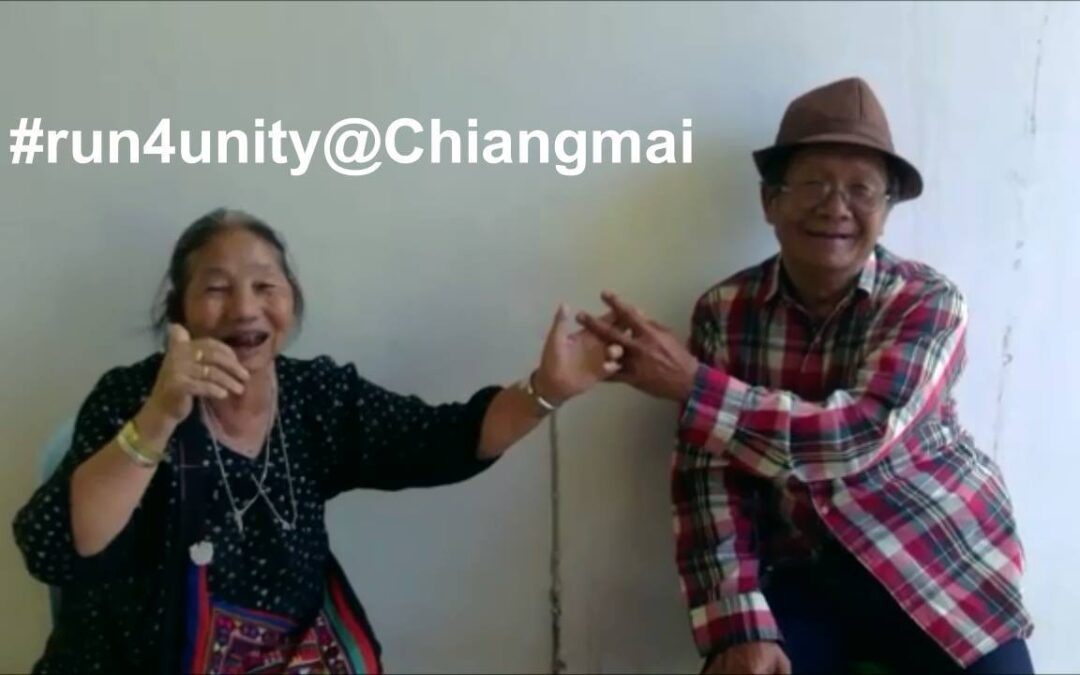
May 12, 2015 | Focolare Worldwide
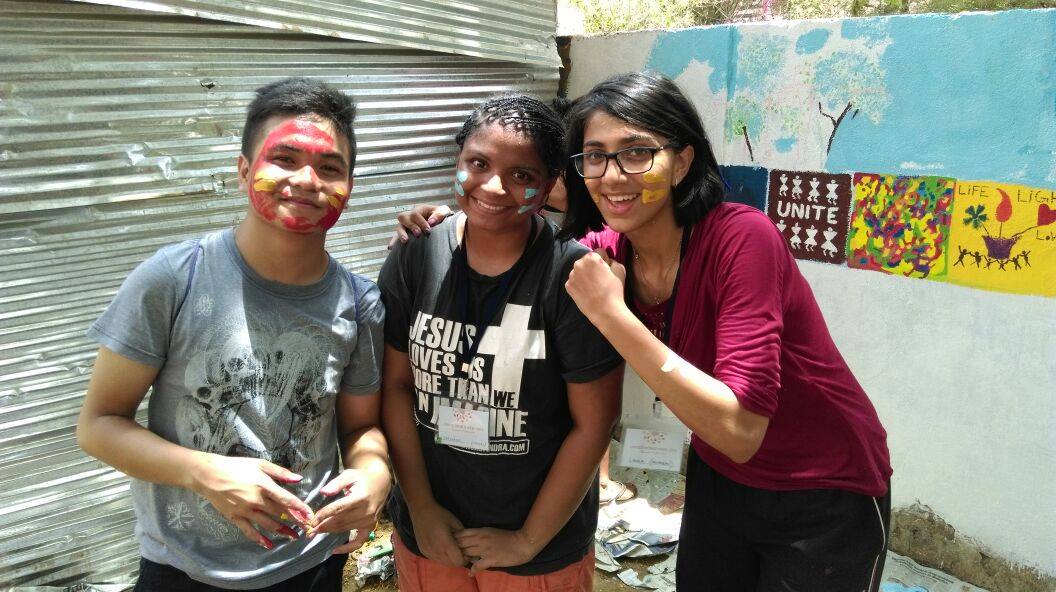 Focolare Youth and children and their many friends. Signs of persistent commitment towards peace in the whole world. A focus on some initiatives, not amongst the most crowded or those held in well-known cities, but very significant because they show that everyone, anywhere can contribute towards peace. Kinshasa, Congo. A convinced crowd of a thousand young people, Christians and Muslims demonstrated in front of civil authorities: mayors, governor, members of parliament, ambassadors. (One boy managed to invite 70 friends who took part in the activity and paid their participation fee in advance). These youngsters marched for about an hour in the chaotic city of Kinshasa until they reached Petite Flamme, the school run by the Focolare Movement and found in Ndolo. This project offers many teens the opportunity to build a future in their own country without having to emigrate. Other young people marched in the unstable east region of Bukavu, Kikwit and Goma. Damascus, Syria. Syrian children have been asked to comment on their situation and answered through social networks: “I am M., and after managing to escape from home I now live in Damascus. During the night our neighbourhood was very heavily bombarded and rockets hit some of our friends’ homes. The Focolare families did their best to find accommodation for them….Some of us lost relatives, friends, school…. But in spite of all this we believe in peace, we live for peace and pray God for peace. We visited children in an orphanage. We organized ourselves and prepared for them sweets, salted biscuits, bracelets….. We played with these children and spent a very nice day together”. Another group of 65 youngsters, coming from different parts of the country, faced the risk of a journey to spend a couple of days together: “It seemed an oasis as it was for the people of Israel who for 40 years journeyed in the desert amidst many hardships”.
Focolare Youth and children and their many friends. Signs of persistent commitment towards peace in the whole world. A focus on some initiatives, not amongst the most crowded or those held in well-known cities, but very significant because they show that everyone, anywhere can contribute towards peace. Kinshasa, Congo. A convinced crowd of a thousand young people, Christians and Muslims demonstrated in front of civil authorities: mayors, governor, members of parliament, ambassadors. (One boy managed to invite 70 friends who took part in the activity and paid their participation fee in advance). These youngsters marched for about an hour in the chaotic city of Kinshasa until they reached Petite Flamme, the school run by the Focolare Movement and found in Ndolo. This project offers many teens the opportunity to build a future in their own country without having to emigrate. Other young people marched in the unstable east region of Bukavu, Kikwit and Goma. Damascus, Syria. Syrian children have been asked to comment on their situation and answered through social networks: “I am M., and after managing to escape from home I now live in Damascus. During the night our neighbourhood was very heavily bombarded and rockets hit some of our friends’ homes. The Focolare families did their best to find accommodation for them….Some of us lost relatives, friends, school…. But in spite of all this we believe in peace, we live for peace and pray God for peace. We visited children in an orphanage. We organized ourselves and prepared for them sweets, salted biscuits, bracelets….. We played with these children and spent a very nice day together”. Another group of 65 youngsters, coming from different parts of the country, faced the risk of a journey to spend a couple of days together: “It seemed an oasis as it was for the people of Israel who for 40 years journeyed in the desert amidst many hardships”. 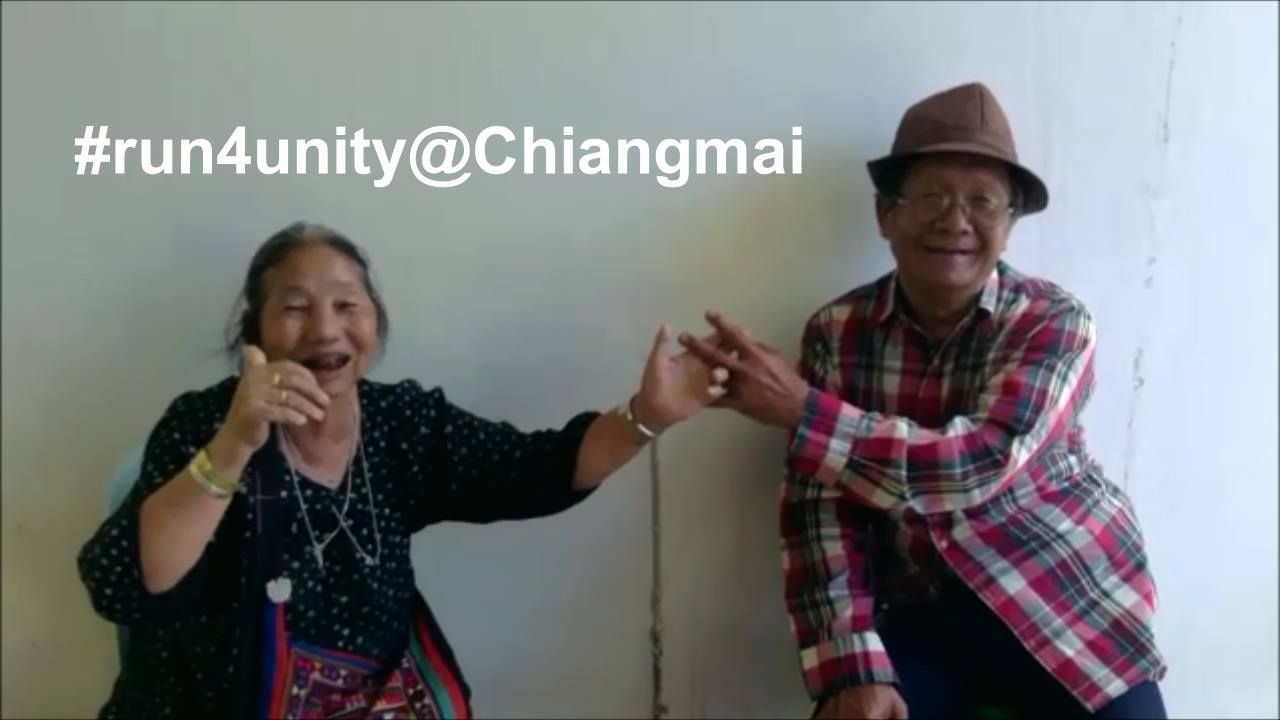 Cascais, Portugal. 900 young Portuguese gathered at the small town of Cascais welcomed the Syrian youth’s commitment to pray and be points of reference for peace in everyday life so as to spread love and peace around them. “They instilled strength and determination in us, helping us to give relative importance to our small difficulties and challenges”. The commissioner for youth policies encouraged them saying: “Continue to believe in what already believe. Continue to be what you are. The world needs you!” Bahía Blanca, Argentina. Through the initiative “Papelitos in the city”, positive messages were scattered everywhere: on school benches, doors, in elevators, in mailboxes, on motorcycles, cars, bicycles…. The golden rule found in sacred books and in other texts stimulated the idea: “Cheer up everybody’s day and contribute to lessen violence”. Other groups (scouts, etc.) took part in this initiative through Whatsapp and Facebook. It has also aroused conflicting ideas that reinforced the youth’s determination to “write those words with their lives”. Hamm, Germany. Catholic and Evangelical youth walked together through the city and stopped at various places of worship, including a mosque and Hindu temple. Slovakia. Slovak and Ukrainian youth and children met at a town on the border between the two countries and organized different activities. Above all, they shared the suffering of a conflict that continues to cause death and destruction. Hong Kong And Macao: The necessity of peace and its absolute priority were promoted in one of the most busy commercial places in Hong Kong, which youth chose as their meeting place. Bethlehem. Christian and Muslim children from Jerusalem, Nazareth and Haifa, who took part in this year’s edition of the relay race for peace, met at the Square of the Basilica of the Nativity in Bethlehem. From there they walked to the Salesian monastery in the Cremisan Valley, where the local people protested without any violence and prevented the building of a part of the wall that separates Israel and the Palestinian Territories. Source:Press releases
Cascais, Portugal. 900 young Portuguese gathered at the small town of Cascais welcomed the Syrian youth’s commitment to pray and be points of reference for peace in everyday life so as to spread love and peace around them. “They instilled strength and determination in us, helping us to give relative importance to our small difficulties and challenges”. The commissioner for youth policies encouraged them saying: “Continue to believe in what already believe. Continue to be what you are. The world needs you!” Bahía Blanca, Argentina. Through the initiative “Papelitos in the city”, positive messages were scattered everywhere: on school benches, doors, in elevators, in mailboxes, on motorcycles, cars, bicycles…. The golden rule found in sacred books and in other texts stimulated the idea: “Cheer up everybody’s day and contribute to lessen violence”. Other groups (scouts, etc.) took part in this initiative through Whatsapp and Facebook. It has also aroused conflicting ideas that reinforced the youth’s determination to “write those words with their lives”. Hamm, Germany. Catholic and Evangelical youth walked together through the city and stopped at various places of worship, including a mosque and Hindu temple. Slovakia. Slovak and Ukrainian youth and children met at a town on the border between the two countries and organized different activities. Above all, they shared the suffering of a conflict that continues to cause death and destruction. Hong Kong And Macao: The necessity of peace and its absolute priority were promoted in one of the most busy commercial places in Hong Kong, which youth chose as their meeting place. Bethlehem. Christian and Muslim children from Jerusalem, Nazareth and Haifa, who took part in this year’s edition of the relay race for peace, met at the Square of the Basilica of the Nativity in Bethlehem. From there they walked to the Salesian monastery in the Cremisan Valley, where the local people protested without any violence and prevented the building of a part of the wall that separates Israel and the Palestinian Territories. Source:Press releases
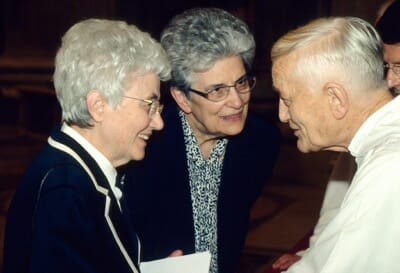
May 12, 2015 | Focolare Worldwide

Chiara Lubich, Gabri Fallacara, Frère Roger Schutz (1978).

Chiara Lubich, Eli Folonari,
May 11, 2015 | Focolare Worldwide

 At the opening session, Bishop Nunzio Galantino, Secretary General of the Italian Episcopal Conference (IEC), declared that «The spirit of the Episcopal Conference is to start from those involved,» underlining how this is also proven by the meeting which saw the participation of all the ecclesial organisations operating in the social fields. «The ecclesial congress of November will start in Prato, the ideal periphery of Florence and home to Chinese immigrants, and where the Pope is scheduled to make his pastoral visit.» In an interview, Prof. Coda summarised the objective of the two-day work session. «We want to reflect and offer our testimonial through the experiences of some dynamic groups of the Church in Italy, that are working in the frontlines of service to the poor and homeless and in creating an open dialogue in all spheres.» The preparatory meeting delved into the theme on “The Servant of the Lord and the humanity of mankind” (15-16 May), organized by the Abele Group and their magazine, “Il Regno,” with the cooperation of the Italian Catholic Action, Carits, CNCA and the Networks of Charity and the Focolare Movement. “Together with the others, Piero Coda continued, these experiences «open out to all the existential frontiers of society, as Pope Francis says.» Furthermore, «in Evangelii Gaudium, Pope Francis uses a beautiful expression: we must say “yes” to all the new relationships generated by Jesus. All the groups involved in this event actualise in various ways, this “yes to new relationships” with the cultural and social divides, marginalisation of all sorts, the world around us, and the home common to all Creation, precisely as an expression of this reality of relationships.» Maria Voce’s presence underlined the Focolare’s adhesion to this preparatory path which aims above all to highlight the life of those who give all their energy every day to creating this “new humanism.” «The Church breaks through the confines of the building of religious rites, and in full communion between the clergy and laity, comes closer to present day humanity,» she affirmed in her speech. This Convention «targets the start of a new season in the life and mission of the Church in Italy: not only with regard to the pressing need for “pastoral conversion” but also for the role and public conduct of Christians in facing the social, economic and political realities of our country and keeping an open attitude toward Europe and the world.» She then referred to the challenges of pluralism and the need to harmonise the multitude of diversities in the public field. «This new season stands for the transformation of the world, starting from the radical conversion of our hearts and minds in order to be ready to meet Jesus in each person. God cannot receive us alone, he wants us to go to him with our brethren… To give the Christian name of fraternity to social relationships means committing ourselves to harmonizing the weft of relationships, recognising our mutual belonging and the bonds of responsibility implied, and orienting personal and collective efforts towards the common good.» This is why «we must give a voice and dignity to those at the periphery, extend the spheres of inclusion, and heal and rebuild the frayed social fabric. It is primarily the youth who wish to give their own contribution. So many initiatives have started up locally, in the heart of numberless fragments of “fraternal” civil life!» As a confirmation of Maria Voce’s words, were the almost 200 members of the Focolare Movement attending the meeting, and involved in many ways in the ecclesial organisations, and active in various fields: interreligious dialogue, reception of immigrants, politics, culture and legality, schooling, and the real opening of worksites for the good of Italy. It is a participation which demonstrates their concrete commitment, together with many other active groups.
At the opening session, Bishop Nunzio Galantino, Secretary General of the Italian Episcopal Conference (IEC), declared that «The spirit of the Episcopal Conference is to start from those involved,» underlining how this is also proven by the meeting which saw the participation of all the ecclesial organisations operating in the social fields. «The ecclesial congress of November will start in Prato, the ideal periphery of Florence and home to Chinese immigrants, and where the Pope is scheduled to make his pastoral visit.» In an interview, Prof. Coda summarised the objective of the two-day work session. «We want to reflect and offer our testimonial through the experiences of some dynamic groups of the Church in Italy, that are working in the frontlines of service to the poor and homeless and in creating an open dialogue in all spheres.» The preparatory meeting delved into the theme on “The Servant of the Lord and the humanity of mankind” (15-16 May), organized by the Abele Group and their magazine, “Il Regno,” with the cooperation of the Italian Catholic Action, Carits, CNCA and the Networks of Charity and the Focolare Movement. “Together with the others, Piero Coda continued, these experiences «open out to all the existential frontiers of society, as Pope Francis says.» Furthermore, «in Evangelii Gaudium, Pope Francis uses a beautiful expression: we must say “yes” to all the new relationships generated by Jesus. All the groups involved in this event actualise in various ways, this “yes to new relationships” with the cultural and social divides, marginalisation of all sorts, the world around us, and the home common to all Creation, precisely as an expression of this reality of relationships.» Maria Voce’s presence underlined the Focolare’s adhesion to this preparatory path which aims above all to highlight the life of those who give all their energy every day to creating this “new humanism.” «The Church breaks through the confines of the building of religious rites, and in full communion between the clergy and laity, comes closer to present day humanity,» she affirmed in her speech. This Convention «targets the start of a new season in the life and mission of the Church in Italy: not only with regard to the pressing need for “pastoral conversion” but also for the role and public conduct of Christians in facing the social, economic and political realities of our country and keeping an open attitude toward Europe and the world.» She then referred to the challenges of pluralism and the need to harmonise the multitude of diversities in the public field. «This new season stands for the transformation of the world, starting from the radical conversion of our hearts and minds in order to be ready to meet Jesus in each person. God cannot receive us alone, he wants us to go to him with our brethren… To give the Christian name of fraternity to social relationships means committing ourselves to harmonizing the weft of relationships, recognising our mutual belonging and the bonds of responsibility implied, and orienting personal and collective efforts towards the common good.» This is why «we must give a voice and dignity to those at the periphery, extend the spheres of inclusion, and heal and rebuild the frayed social fabric. It is primarily the youth who wish to give their own contribution. So many initiatives have started up locally, in the heart of numberless fragments of “fraternal” civil life!» As a confirmation of Maria Voce’s words, were the almost 200 members of the Focolare Movement attending the meeting, and involved in many ways in the ecclesial organisations, and active in various fields: interreligious dialogue, reception of immigrants, politics, culture and legality, schooling, and the real opening of worksites for the good of Italy. It is a participation which demonstrates their concrete commitment, together with many other active groups.



 Cascais,
Cascais, 
